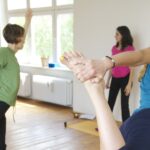For many people in the West, yoga is something that happens in classes, at a yoga studio, with a teacher who they don’t particularly know, in a room full of people who are more or less strangers. This is a relatively new phenomenon in the history of yoga, and this model of teaching and learning yoga asana, pranayama and meditation is basically an outgrowth of the economy of fitness, physiotherapy, massage and other wellness modalities in the West. The class/studio model has some benefits: most notably, some studio owners have found it very lucrative, and the commercialization of yoga has also lead to its legitimization in some people’s eyes. It’s not, however, a teaching model that is necessarily the most effective for either students or teachers. It’s also a model that raises some serious concerns about commercialism, capitalism and cultural appropriation. And, on an individual level, relying on classes alone can be expensive, disheartening or frustrating and often is just not feasible over the long-run.
This is why, as most teachers will tell you, creating a personal yoga practice—one that you do at home, alone, with yourself as the teacher and perhaps some resources to guide you—is an important step to take. Often students are intimidated by this idea, but integrating yoga into daily life a lot easier than one might think. In this article, I’d like to offer some easy tips for starting a Home Practice that reflects you, your schedule, your family/work/community responsibilities and your needs.
1. Go Slow
By which I mean, start off with a modest goal: for example, 10 minutes of sun salutations in the morning, or 10 minutes breathing deeply in child’s pose. You will probably need to build your own confidence and your own commitment to the idea. You might also need to get people in your life (like children, roommates or partners) used to the idea of you taking time for yourself at home. Like all habits, It’s a lot easier to do this slowly and incrementally. When you feel ready, you can expand your sessions to 20 or 30min. If you get to an hour one day—well, hats off to you! But if you don’t—don’t stress about it. Yoga benefits you after just 10minutes of practice, and rigidity and guilt aren’t attitudes that will help you in the long run.
2. Reward Yourself
Look, it’s hard work. Even the so-called yoga basics (breathing, awareness and movement) require a high level of attention, commitment and self-love. If you’re like most yogis (advanced, as well as beginner yogis!), you’re probably facing up against a bunch of internal chatter, anxiety, worry and negativity. So, when you meet your modest goal, reward yourself! Cook yourself a lovely meal; make a coffee date with a friend; visit a museum or a botanical garden. Do something nice for yourself, and be proud of yourself.
3. Experiment and Have Fun
Because of the way most of us were educated (in classrooms, in schools and other institutions), we tend to subconsciously associate experimentation with the risk of messing up, ‘doing it wrong’ or getting in trouble. From a spiritual perspective, these kinds of risks are absolutely essential to take; if you don’t let yourself be vulnerable, you can’t grow. And, in your yoga practice, not only are risks essential, but they can also be a lot of fun! You can close the door while you practice—and then let yourself fall over, dance, move in uncontrolled ways that feel good, make noise, whatever works for you! Don’t be constrained by what you know of yoga asanas; feel free to integrate freestyle movement, or influences from other movement modalities, like martial arts or dance. Your yoga practice doesn’t have to look like anyone else’s, and it’s not anyone else’s business what you do or how you do it.
4. Make Your Place
This can be tricky, because you probably share living space. But all it really requires is good communication; tell your people that, when you close the door to the bedroom and hang a red ribbon on the door, it means 30minutes of personal time. Or choose a time of day where everyone else is out of the house. Or go up onto the roof. Or into the garden. Or organize a time with where you all come together into the living room, and do your individual practices alone. Be creative and, again, take it slow; it might take some time for people to get used to it. And, finally, it’s a great idea to spend 1 or 2 minutes clearing up the space in which you plan to practice; if you’re down on the ground, you will see all of the dirt and dust at close-range! It’s easier to focus when you’ve already swept it away.
5. Take Classes To Give Yourself New Ideas/Find A Good Teacher
This is where classes can be really great. Let’s say you’ve been doing 30min of yoga asana and pranayama every morning, and you’re feeling pretty good about it, but you feel a bit stuck with how to go develop further; maybe you feel you don’t have the knowledge or experience, or maybe you just don’t have the inspiration or the motivation. Maybe you would like to learn more about less-widely-taught parts of yoga: Yoga Nidra, Tratak, the Yamas and Niyamas or the Shatkarma. Well, this is where a good teacher comes in handy. Find a teacher who supports your home practice/exploration and attend classes or workshops occasionally with this person; someone with experience and empathy, who can support you and point you in the right direction, but who believes firmly that you are your own teacher and that their role is to develop your contact to this inner teacher.
6. Finally, Make It Your Own
Many of us have rather rigid ideas about ‘what yoga is’ or ‘how to do yoga’. Well, as you have probably heard about a million times, yoga means ‘union’—unifying your mind, body, heart and soul (and, I would add, creating connections between yourself, your community and the ecology that supports you) is the only ‘goal’. If you decide that your home practice will include 30minutes of journaling, because this helps you bring yourself into unity—wonderful. If you want to dance, sing, massage yourself, pray, draw, have orgasms, garden, laugh, cry, clean your room, take a shower—all of those can be part of your yoga practice. As long as you’re doing it with love, attention, awareness and intention, it’s yoga. Your home practice is your DIY spiritual practice, and it should be as unique as you are.
Good luck! Please feel free to let me know how your home practice is developing, either by contacting me or coming by an english yoga class in at our Berlin yoga studio in Kreuzberg.







